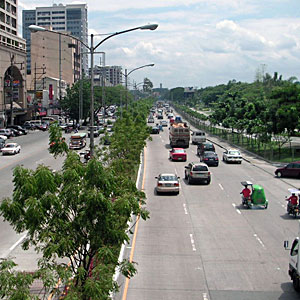A seemingly peaceful zone in Quezon City’s university belt has its fair share of crimes. Katipunan Avenue, now C.P. Garcia Avenue, is a long road stretch where some of the biggest universities, commercial establishments, private subdivisions, and call centers are situated.
Although the zone is where students from ’posh’ schools hang out after class and nearby exclusive subdivisions are relatively peaceful and safe, the vicinity surrounding the academic, business, and residential sites has several stories of street crimes. Some hold-ups, assaults, and homicide cases were recorded in the past and isolated cases still prevail.
What makes the area ‘crime-prone’? This is probably brought by the perception of having well-off residents living in the area that attract troublemakers to barge in or the poor and uneducated community contributing to the rising criminality.
In a community where about 85,000 displaced families have made the streets their dwelling place and people from the provinces are trying their luck in the capital, the increasing crime rate is not surprising. Overcrowding and poverty are a major concern resulting to many people struggling to survive amid the lawlessness on the streets.
The number of unemployed has swelled to three million in the metropolis and the effects of the global financial crunch are expected to hit the country with detrimental effects to the economy.
Need to be Proactive
Residents of the Katipunan communities realized that several initiatives should be put in place if they want to be secured. This led to the development of the Peace and Order Initiative aimed to safeguard its members against attacks and protect the main district from any untoward incidents.
According to Michael Melchor, CSP, author of the Katipunan Peace and Order Initiative, the plan is to encourage the stakeholders’ involvement in keeping the zone safe for students, residents, and business owners. Developing programs that will help “enhance the response efficiency of local authorities, increase public safety and address poverty reduction measures” will strengthen this. The plan consists of three programs, namely: Street Smarts, Big Brother, and Safe Haven.
Street Smarts
The Street Smarts program is aimed at students, workers, shoppers, and other members of the community who take public transport or pass through the C.P. Garcia Avenue during the night, like call center agents. Street Smarts is a self-defense training program designed for women, children, and the elderly to protect themselves against assaults. It includes an information campaign discussing risks and proper responses to attacks.

Big Brother Assistance
The prevalence of squatters in the midst of a middle-class neighborhood has always been a concern of the Katipunan community. Street children from depressed areas usually scourge for food scraps and refuse from households and business establishments. Spending a difficult life in the streets pushes the children to do petty crimes to eat.
To meet their daily needs, some street children do what is unlawful harming those living in the community. Lack of family support and good values also lead street children to commit crimes. As parents, driven by poverty, have neither time nor resources to take care of their children. In the long run, these children find comfort in the company of gangs, addicts or syndicates.
The Katipunan Peace Initiative believes that combating crimes starts from protecting the street children and driving them away to all possibilities of becoming would-be criminals. Instead of sorting garbage, begging, or stealing, the street children are taught basic skills to enable them to earn decent livelihood as they grow up. Participation of the private sector within the Katipunan district is a worthwhile endeavor towards a noble end, while civic organizations involvement will help the children learn their self-worth and good family values.
Safe Havens for Victims
Addressing reported crimes on C.P. Garcia Avenue has led to the birth of providing assistance to the victims. Safe havens are places where victims can seek refuge in cases of attacks or emergencies. These havens are also used as training centers for those who want to help prevent crimes through the assistance of police and security professionals. Building a network among community members, safe haven centers and police forces could hold coordinated moves against unscrupulous activities and attend to emergencies, such as fire or accidents.
Safe Haven program relies on the coordination of the security experts and community members by employing mobile communication. Empowering citizens to combat crimes can be done through the use of their cell phones when taking crime photos and sending these to Safe Haven numbers. They can also ask for help via text or seek help if they have been victims of a petty crime.
Noble Goals
Should the Katipunan Peace and Order Initiative succeed, its effects will be sustainable. Involving community members is not easy. It has shown in the past that despite increasing crimes, many members are turning a blind eye on the issue.
A concerted effort among civic groups, businesses, and security experts is key to keeping criminality at bay. The roles of technology and data management are innovative approaches to understand criminal acts and predicting where crimes often occur, including all factors that contribute to criminal offenses.
Perhaps the most enduring lesson from this initiative is to identify the social issues related to criminal activities. Poverty and indifference bring up future criminals just like gangs and street hooligans do.•







